产品中心
当前位置:首页>产品中心Anti-Elastin
货号: bs-11057R 基本售价: 1380.0 元 规格: 100ul
- 规格:100ul
- 价格:1380.00元
- 规格:200ul
- 价格:2200.00元
产品信息
- 产品编号
- bs-11057R
- 英文名称
- Elastin
- 中文名称
- 项韧带弹性蛋白抗体
- 别 名
- Elastin; ELN; SVAS; Tropoelastin; WBS; WS.ELN_BOVIN.
- 规格价格
- 100ul/1380元购买 200ul/2200元购买 大包装/询价
- 说 明 书
- 100ul 200ul
- 研究领域
- 神经生物学 信号转导 细胞粘附分子 细胞外基质
- 抗体来源
- Rabbit
- 克隆类型
- Polyclonal
- 交叉反应
- Human, Mouse, Rat, Dog, Pig, Cow,
- 产品应用
- WB=1:500-2000 ELISA=1:500-1000 IHC-P=1:400-800 IHC-F=1:400-800 ICC=1:100-500 IF=1:100-500 (石蜡切片需做抗原修复)
not yet tested in other applications.
optimal dilutions/concentrations should be determined by the end user.
- 分 子 量
- 80kDa
- 细胞定位
- 细胞外基质 分泌型蛋白
- 性 状
- Lyophilized or Liquid
- 浓 度
- 1mg/ml
- 免 疫 原
- KLH conjugated synthetic peptide derived from bovine Elastin:101-200/747
- 亚 型
- IgG
- 纯化方法
- affinity purified by Protein A
- 储 存 液
- 0.01M TBS(pH7.4) with 1% BSA, 0.03% Proclin300 and 50% Glycerol.
- 保存条件
- Store at -20 °C for one year. Avoid repeated freeze/thaw cycles. The lyophilized antibody is stable at room temperature for at least one month and for greater than a year when kept at -20°C. When reconstituted in sterile pH 7.4 0.01M PBS or diluent of antibody the antibody is stable for at least two weeks at 2-4 °C.
- PubMed
- PubMed
- 产品介绍
- background:
Elastic fibers, which are comprised primarily of elastin, endow loose connective tissue with a resilience that compliments the tensile strength of collagenous fibers. Elastin is the main component of the extracellular matrix of arteries, and it performs a regulatory function during arterial development by controlling proliferation of smooth muscle and stabilizing arterial structure. Elastin is composed largely of glycine, proline, and other hydrophobic residues, and it contains multiple lysine-derived crosslinks, such as desmosines, which link individual polypeptide chains into a rubber-like network. During aging, the elasticity of connective tissue becomes reduced because of the cross-linking of collagenous fibers with elastin. Deficiencies of elastin are associated with multiple disorders, such as supravalvular aortic stenosis and Williams-Beuren syndrome. The human elastin gene maps to chromosome 7q11.23.
Function:
Major structural protein of tissues such as aorta and nuchal ligament, which must expand rapidly and recover completely. Molecular determinant of the late arterial morphogenesis, stabilizing arterial structure by regulating proliferation and organization of vascular smooth muscle.
Subunit:
The polymeric elastin chains are cross-linked together into an extensible 3D network. Forms a ternary complex with BGN and MFAP2. Interacts with MFAP2 via divalent cations (calcium > magnesium > manganese) in a dose-dependent and saturating manner.
Subcellular Location:
Secreted, extracellular space, extracellular matrix. Note=Extracellular matrix of elastic fibers.
Post-translational modifications:
Elastin is formed through the cross-linking of its soluble precursor tropoelastin. Cross-linking is initiated through the action of lysyl oxidase on exposed lysines to form allysine. Subsequent spontaneous condensation reactions with other allysine or unmodified lysine residues result in various bi-, tri-, and tetrafunctional cross-links. The most abundant cross-links in mature elastin fibers are lysinonorleucine, allysine aldol, desmosine, and isodesmosine.
Hydroxylation on proline residues within the sequence motif, GXPG, is most likely to be 4-hydroxy as this fits the requirement for 4-hydroxylation in vertebrates.
Similarity:
Belongs to the elastin family.
SWISS:
P04985
Gene ID:
2006
Database links:Entrez Gene: 2006Human
Entrez Gene: 25043Rat
Omim: 130160Human
SwissProt: P15502Human
SwissProt: P54320Mouse
SwissProt: Q99372Rat
Unigene: 647061Human
Unigene: 275320Mouse
Unigene: 404771Mouse
Unigene: 54384Rat
Important Note:
This product as supplied is intended for research use only, not for use in human, therapeutic or diagnostic applications.
- 产品图片
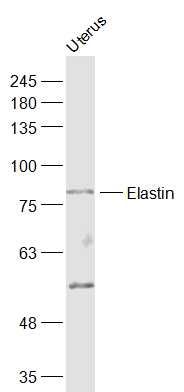 Sample:
Sample:
Uterus (Mouse) Lysate at 40 ug
Primary: Anti-Elastin (bs-11057R) at 1/1000 dilution
Secondary: IRDye800CW Goat Anti-Rabbit IgG at 1/20000 dilution
Predicted band size: 80 kD
Observed band size: 80 kD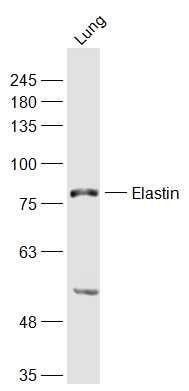 Sample:
Sample:
Lung (Mouse) Lysate at 40 ug
Primary: Anti-Elastin (bs-11057R) at 1/1000 dilution
Secondary: IRDye800CW Goat Anti-Rabbit IgG at 1/20000 dilution
Predicted band size: 80 kD
Observed band size: 80 kD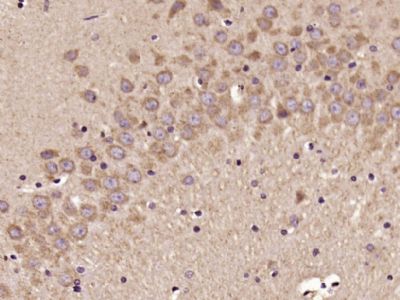 Paraformaldehyde-fixed, paraffin embedded (Rat brain); Antigen retrieval by boiling in sodium citrate buffer (pH6.0) for 15min; Block endogenous peroxidase by 3% hydrogen peroxide for 20 minutes; Blocking buffer (normal goat serum) at 37°C for 30min; Antibody incubation with (Elastin) Polyclonal Antibody, Unconjugated (bs-11057R) at 1:500 overnight at 4°C, followed by a conjugated secondary (sp-0023) for 20 minutes and DAB staining.
Paraformaldehyde-fixed, paraffin embedded (Rat brain); Antigen retrieval by boiling in sodium citrate buffer (pH6.0) for 15min; Block endogenous peroxidase by 3% hydrogen peroxide for 20 minutes; Blocking buffer (normal goat serum) at 37°C for 30min; Antibody incubation with (Elastin) Polyclonal Antibody, Unconjugated (bs-11057R) at 1:500 overnight at 4°C, followed by a conjugated secondary (sp-0023) for 20 minutes and DAB staining.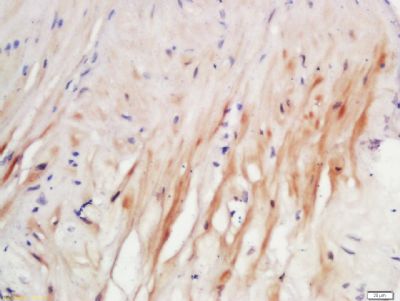 Tissue/cell: human cervical cancer; 4% Paraformaldehyde-fixed and paraffin-embedded;
Tissue/cell: human cervical cancer; 4% Paraformaldehyde-fixed and paraffin-embedded;
Antigen retrieval: citrate buffer ( 0.01M, pH 6.0 ), Boiling bathing for 15min; Block endogenous peroxidase by 3% Hydrogen peroxide for 30min; Blocking buffer (normal goat serum,C-0005) at 37℃ for 20 min;
Incubation: Anti-Elastin Polyclonal Antibody, Unconjugated(bs-11057R) 1:200, overnight at 4°C, followed by conjugation to the secondary antibody(SP-0023) and DAB(C-0010) staining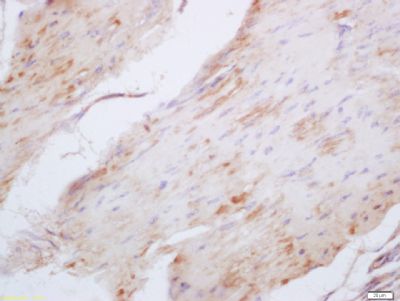 Tissue/cell: mouse stomach wall; 4% Paraformaldehyde-fixed and paraffin-embedded;
Tissue/cell: mouse stomach wall; 4% Paraformaldehyde-fixed and paraffin-embedded;
Antigen retrieval: citrate buffer ( 0.01M, pH 6.0 ), Boiling bathing for 15min; Block endogenous peroxidase by 3% Hydrogen peroxide for 30min; Blocking buffer (normal goat serum,C-0005) at 37℃ for 20 min;
Incubation: Anti-Elastin Polyclonal Antibody, Unconjugated(bs-11057R) 1:200, overnight at 4°C, followed by conjugation to the secondary antibody(SP-0023) and DAB(C-0010) staining

